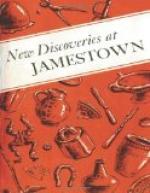[Illustration: The Jamestown cooper was A busy craftsman. Many barrels, hogsheads, and casks were needed in the colony, and large quantities of barrel staves were made for shipping to England. (Painting by Sidney E. King.)]
Artisans and Craftsmen
Numerous objects recovered at Jamestown are extremely important as they reveal the kinds of craftsmen and artisans who worked in Virginia’s first capital, the nature of their tools and equipment, and examples of their handiwork.
THE CARPENTER
Scores of tools used by the men who helped build the Jamestown houses have been unearthed, including chisels, augers, gouges, hammers, reamers, saw fragments, bits, axes and hatchets, plane blades, gimlets, files, calipers, compasses, scribers, nail pulls, and a saw wrest. A grindstone was found in a refuse pit not far from the historic church tower.
THE COOPER
Some tools used by the cooper, including draw shaves, adzes, plane irons, and race knives, have been excavated. Several barrel staves—probably made at Jamestown—were found in a few wells. Because of the great demand for barrels, casks, and hogsheads (both in Virginia and England) the Jamestown cooper was a busy artisan. His products were needed at all times, especially after 1620 when the Virginia settlers began shipping large quantities of tobacco to England in wooden hogsheads.
[Illustration: Timbering—one of the first English industries in the new World. (Painting by Sidney E. King.)]
[Illustration: An early 17th-century, two-man, crosscut saw.]
THE WOODCUTTER AND SAWYER
Numerous tools found on Jamestown Island relate to timbering, including felling axes, hewing axes, hatchets, saws, and wedges. An early 17th-century two-man crosscut saw has been recovered almost intact. Records indicate that pit saws were used, although none has been excavated.
THE IRONWORKER
A small, primitive hearth or furnace, where small amounts of iron may have been smelted during the early part of the 17th century, was uncovered during archeological explorations in 1955. A few miles upriver from Jamestown, at Falling Creek, the English built their first iron furnace in America in 1620-21. Iron was smelted in the furnace, and a few tools were forged—the first iron objects made in the New World by the English. In 1622 the Indians massacred the ironworkers and their families, and destroyed the furnace. Although it was never rebuilt, its importance cannot be overstressed, for the Falling Creek site can rightfully claim the honor of being the birthplace of the American iron industry.




